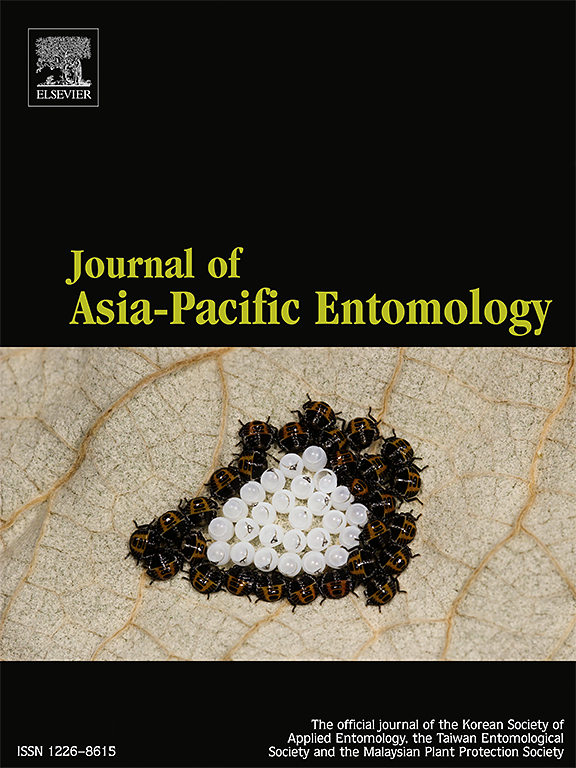蜜蜂在苹果花上传播磷光色素的比较研究
IF 1.1
3区 农林科学
Q3 ENTOMOLOGY
引用次数: 0
摘要
蜜蜂媒介技术是利用蜜蜂的授粉行为来控制作物病虫害的技术,已经在各种研究中得到证实。蜜蜂媒介的使用主要集中在欧洲蜜蜂,Apis mellifera。本研究旨在比较蜜蜂蜂和蜜蜂蜂在苹果花中的活动和传播效率。采用解淀粉芽孢杆菌MBI600 (Bacillus amyloliquefaciens MBI600)与磷光色素(MAMP)混合,观察和跟踪蜜蜂的传播过程。相较于蜜蜂(6:27 AM和12.45 h),蜜蜂开始觅食的时间较早(5:36 AM),持续时间较长(13.39 h),随着温度的升高,蜜蜂的觅食活动明显高于蜜蜂。上午9点,蜜蜂花在花上的时间为9.2±5.4秒,蜜蜂花在花上的时间为7.0±7.8秒。两种苹果花磷光色素的检出率均为100%。在柱头上,蜜蜂的检出率为98.0%,蜜蜂的检出率为96.0%。两种植物在花药上的检出率均为100%。在两次提供MAMP后,蜜蜂每朵花平均提供6.6µg磷光色素,而蜜蜂每朵花提供4.9µg磷光色素。然而,两种之间没有显著差异。虽然已知一只蜜蜂工蜂在其身体上释放的量比蜜蜂工蜂少,但在蜜蜂释放期间,两种蜜蜂在一朵花上释放的量是相似的。据推测,这是由于它们觅食行为和活动的差异造成的。因此,在小规模果园中,蜜蜂可能是一种替代的媒介蜜蜂。它也可以用于果园环境,在那里蜜蜂的使用受到限制,如在低温条件下。本文章由计算机程序翻译,如有差异,请以英文原文为准。

Comparison of phosphorescent pigment dissemination for bee vectoring by Apis cerana and Apis mellifera on apple flowers
The bee vectoring technology, which utilizes the pollination behavior of bees to control pests and diseases of crops, has been demonstrated in various studies. Bee vectoring using honey bees has primarily focused on European honey bee, Apis mellifera. This study aims to compare the activity and dissemination efficiency of A. mellifera and A. cerana in apple flowers. To observe and track the dissemination process by honey bees, the microbial agent (Bacillus amyloliquefaciens MBI600 against fire blight) mixed with the phosphorescent pigment (MAMP) was used. A. cerana began foraging earlier (5:36 AM) and continued longer (13.39 h) than A. mellifera (6:27 AM and 12.45 h). As the temperature increased, A. cerana showed higher foraging activity than A. mellifera. At 9 a.m., A. mellifera spent more time on flowers (9.2 ± 5.4 sec) compared to A. cerana (7.0 ± 7.8 sec). The detection rate of phosphorescent pigment on apple flowers was 100 % for both species. On the stigma, the detection rates were similar, with A. mellifera at 98.0 % and A. cerana at 96.0 %. Both species showed 100 % detection rates on the anther. After two supplies of MAMP, A. mellifera delivered an average of 6.6 µg of phosphorescent pigment per flower, while A. cerana delivered 4.9 µg. However, there was no significant difference between the two species. While it is known that one A. cerana worker delivers a smaller amount on its body than A. mellifera, the amount delivered to a single flower during the release period of the honey bees was similar between the two species. This is presumed to result from differences in their foraging behaviors and activities. As a result, A. cerana could be an alternative vectoring bee in small-scale orchards. It could also be used in orchard environments where the use of A. mellifera is restricted, such as under low-temperature conditions.
求助全文
通过发布文献求助,成功后即可免费获取论文全文。
去求助
来源期刊

Journal of Asia-pacific Entomology
Agricultural and Biological Sciences-Insect Science
CiteScore
2.70
自引率
6.70%
发文量
152
审稿时长
69 days
期刊介绍:
The journal publishes original research papers, review articles and short communications in the basic and applied area concerning insects, mites or other arthropods and nematodes of economic importance in agriculture, forestry, industry, human and animal health, and natural resource and environment management, and is the official journal of the Korean Society of Applied Entomology and the Taiwan Entomological Society.
 求助内容:
求助内容: 应助结果提醒方式:
应助结果提醒方式:


